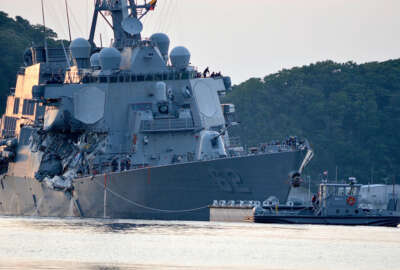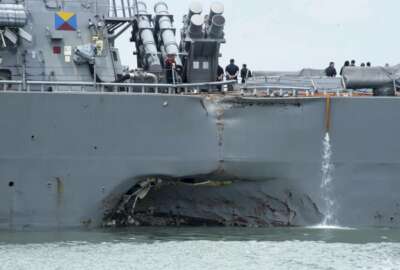
Navy promises sailors more predictable sleep schedules, duty assignments in 2018
In 2018, the Navy is implementing new sleep and ship deployment schedules for its 7th Fleet after four major accidents in the prior year.
Subscribe to Federal Drive’s daily audio interviews on iTunes or PodcastOne.
In the busy 7th Fleet, whose area of operations included four major accidents in 2017, the Navy says it cannot promise its sailors a reduced operating tempo in 2018. But at a minimum, it owes servicemembers more predictable schedules and reasonable work hours.
On Nov. 30, the commander of the service’s surface fleet issued new, previously-promised rules ordering commanders to ensure that sailors’ duty schedules are arranged in such a way to let sailors sleep in cycles that follow the human body’s circadian rhythm: resting and working during roughly the same times each day.
While each ship’s commanding officer has some latitude in implementing the new rules, the guidance tells them that they should aim to give each sailor at least seven hours of sleep per day, including a minimum of five hours of uninterrupted sleep, and that not doing so leaves personnel in a mental state of long-term “jet lag.”
The new rules also incorporate U.S. Coast Guard guidance suggesting shipboard workdays of no more than 12 hours each, and preexisting rules from the Navy’s own aviation community based on studies that showed accident rates skyrocketed when personnel were awake for 18 hours or more at a time.
“Sailors are exposed to a variety of operational risk factors including unpredictable schedules, long work days and heavy workloads. These risk factors degrade a sailor’s productivity and warfighting capability,” Naval Surface Force officials wrote in the new instruction. “Incumbent upon every sailor is his or her professional responsibility to take advantage of sleep opportunities to support safe and professional shipboard operations. Sailors who are provided with protected sleep periods but deliberately fail to take advantage of them are suboptimizing their performance and may be subjecting their ship and shipmates to increased risk of mishap or error.”
According to the Government Accountability Office, some 7th Fleet sailors were working up to 108-hour workweeks in the years leading up to the 2017 accidents, which included two deadly collisions, one non-fatal collision and one grounding.
Navy officials have quibbled with that statistic, but the service’s own comprehensive review examining the U.S.S. John McCain and U.S.S. Fitzgerald accidents confirmed that sailors aboard 21 out of the 22 ships in the Japan-based fleet had shown troubling rates of complaints about exhaustion, high stress and lack of sleep in surveys. The review said one contributing factor was manning shortfalls of between 15 and 20 percent in some enlisted specialties.
Speaking to sailors aboard the U.S.S. Ronald Reagan in Yokosuka, Japan, Adm. John Richardson, the chief of naval operations, said the service would be taking additional steps to give servicemembers more predictability in their work lives, beyond their daily duty schedules.
“Part of the corrective action that we are undertaking is that we owe you a firm and deliberate schedule for the next year,” he said. “Something that you can bank on, you can schedule to. That has to include appropriate time for maintenance, for you to go to school, for underway training.”
Richardson said the Navy’s new 7th Fleet commander, Vice Adm. Phillip Sawyer, has just completed a 2018 schedule for ship deployments in line with those objectives.
“It’s fresh off the presses right now, but for the next year or so, we’re going to stick to it so that you get the training you need to get to the very high end of maritime warfare, and I think you’re going to find that life is a little bit better that way,” Richardson said.
However, sticking to the schedule is a matter that’s not entirely within the Navy’s control.
As a separate strategic review Navy Secretary Richard Spencer ordered following the 2017 accidents pointed out, demands for Navy presence and operations have been within the purview of regional combatant commanders — not the Navy itself — ever since the command and control of U.S. military forces was restructured in 1986 as part of the Goldwater-Nichols Act.
The Navy has been reluctant to say “no” to missions assigned by U.S. Pacific Command or other COCOMs, even when it does not have sufficient ships or personnel to perform them within its own readiness standards.
“This has created an ‘operations-first’ mentality that was reinforced by the overall ‘must do’ culture of the Navy,” according to that report. “This, in turn, obscured current fleet readiness and incurred long-term risk in order to accomplish near-term missions. While an advantage in combat, this ‘must-do’ attitude can have far-reaching and deleterious effects on overall long-term readiness. The Navy must restore readiness standards and the culture that enforces them, while informing civilian and military leadership of the consequential impact of less continuous Navy presence around the world.”
The authors, former chief of naval operations Gary Roughead and Defense Business Board chairman Michael Bayer, recommended that Congress and the Navy take a new look at what they said were negative consequences of Goldwater-Nichols, particularly its emphasis on joint duty assignments that they said take naval officers away from critical operational assignments and subsequent Pentagon reorganizations that bloated the Navy’s staff bureaucracy.
That wave of Pentagon reforms 30 years ago was prompted, in large part, by a major military failure: the 1980 attempt to rescue American hostages in Iran, an operation known as Desert One.
Richardson said he is actively looking for analogies between that incident and the “very tough year” the 7th fleet faced in 2017.
“From that disaster, we also took the opportunity to stand up Special Operations Command and all the exquisite work that our SEALs and Delta Force and all of our special operators do today,” he said. “And so the question is, are there any similarities between that and what we’re facing today? From a very basic perspective, I would have to say yes. We’re going to use this opportunity to put in place measures that will make us a far more professional Navy, and we’re going to put in place measures that will make us a lot deadlier and operationally proficient. I’m not talking about something that’s going to come about in 2030 or 2025, I’m talking about things that are going to be happening in 2018 that are going to get us there. This is a sense of urgency.”
Copyright © 2025 Federal News Network. All rights reserved. This website is not intended for users located within the European Economic Area.
Jared Serbu is deputy editor of Federal News Network and reports on the Defense Department’s contracting, legislative, workforce and IT issues.
Follow @jserbuWFED





